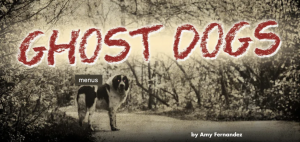Ghost Dogs
by Amy Fernandez
From the archives of The Canine Chronicle
 As a rule, dog people confront things head on without recourse to fantasy or rationalization. That overriding, collective personality trait is therefore difficult to reconcile with our secret vice– an enduring fascination with supernatural dog stories. Edward Ashe wasn’t the most meticulous canine historian, but his perceptive empathy for dog people remains unrivaled. He knew his audience well enough to devote an entire chapter to Dog Ghosts in This Doggie Business. “There is something very attractive about them. They make the world less dull, sharpening our brains as we try and find explanations of their extraordinary actions.” Not much has changed since he addressed this issue, except perhaps an additional century of unexplainable episodes to keep us enthralled. Even so, we never tire of those time honored classics like Sir Arthur Conan Doyle’s infamous canine phantom, the Hound of the Baskervilles.
As a rule, dog people confront things head on without recourse to fantasy or rationalization. That overriding, collective personality trait is therefore difficult to reconcile with our secret vice– an enduring fascination with supernatural dog stories. Edward Ashe wasn’t the most meticulous canine historian, but his perceptive empathy for dog people remains unrivaled. He knew his audience well enough to devote an entire chapter to Dog Ghosts in This Doggie Business. “There is something very attractive about them. They make the world less dull, sharpening our brains as we try and find explanations of their extraordinary actions.” Not much has changed since he addressed this issue, except perhaps an additional century of unexplainable episodes to keep us enthralled. Even so, we never tire of those time honored classics like Sir Arthur Conan Doyle’s infamous canine phantom, the Hound of the Baskervilles.
That spectral guardian of the Yorkshire Moors wasn’t working its game alone. Its littermates enjoyed equally illustrious careers patrolling desolate roads, graveyards, rickety bridges, and ominous crossroads. From a behavioral standpoint, they demonstrate a consistent preference for locations that provide portals to otherworldly realms. This predilection isn’t the only uniform feature of this spectral canine clan. Although they vary in size, their black coats and red eyes are also acknowledged hallmark traits. And Britain certainly had no monopoly on them. Cultural lore from every continent confirms the sustained viability of this notorious strain.
North America seems to be a haven for them. Among others, the Shunka Warakin haunts the Great Plains. Farther north the Adlet, Waheela, and Amarok respectively patrol the eastern, central, and western Arctic frontiers alternately dismembering, decapitating and drowning unlucky victims. Actually, we’ve got one right here in Meriden, Connecticut. As its name suggests, Hanging Hills can be somewhat sinister. Bordering the Quinnipiac River, that ambiance is highlighted by cheery local landmarks like Misery Brook. Nonetheless, for centuries its soaring cliffs and magnificent views have lured admirers to this ancient Native American territory, especially West Peak’s sheer ridges packed with Jurassic treasures. Along with scientists and nature lovers, the Black Dog of West Peak also has an unshakable fondness for this spot.
By the late 1800s it was the acknowledged cause of numerous hiking and climbing fatalities when it made new headlines. Geologist William Pynchon first encountered the Dog in spring 1888. Reprising his experience for the Connecticut Quarterly a decade later he admitted, “It may seem strange that a man of science should believe a tale for the superstitious, but I do believe it. And if you would know why, listen…Many have seen him once, a few twice—none have ever told of the third meeting. It is a short haired black dog of moderate size, with nothing particularly noticeable in its actual appearance. His lineage was evidently uncertain. Yet there are two signs by which it is ever known:—men have seen it bark, but have heard no sound; and it leaves no footprint behind it on the dust of summer or the snow of winter.”
It shadowed Pynchon along West Peak’s desolate trails all day. “I took a great liking to that dog. So I let him go with me for the sake of his good company.” He never got a good close look at his elusive sidekick and eventually it vanished before his eyes. By then, he understandably decided to call it a day and headed back to Meriden for a drink where he shared his experience to a local bartender who gave him the 411. “See it once, it brings joy. See it twice it brings woe. See it three times, it brings death.”
In February 1891 the U.S. Geographical Survey sent Pynchon back to Hanging Hills to photograph rock formations, teaming him with fellow geologist Herbert Marshall. “Marshall had been all over the region thoroughly in his work for the United States Geological Survey and he had climbed West Peak many times and at all seasons of the year.” Naturally, the Dog came up in conversation. Marshall admitted to having seen it twice, “but he laughed at the legend, saying that he did not believe in omens unless they were lucky ones. So we turned in and forgot all about omens, good or bad.” Next morning they set off for West Peak summit, a normally hazardous trek worsened by ice, deep snow, and high winds. Mission accomplished, they began their treacherous descent when Marshall’s attention was diverted. “I did not believe it before. I believe it now; and it is the third time.” Reportedly, the Dog peered down at him from a cliff as he uttered those fateful words and sailed over an icy ravine. That was Marshall’s last geological survey and Pynchon should have known better. But as the New York Herald later reported, he was back a few years later, “at the head of the work on the West Peak area. On November 12th his body was found at the foot of the southern cliff of the Peak. Apparently he had fallen from the top, a distance of some forty feet. It is a singular fact that the body was found on almost the identical spot where his friend, Herbert Marshall, met his death six years before.”
Short URL: https://caninechronicle.com/?p=257673
Comments are closed












